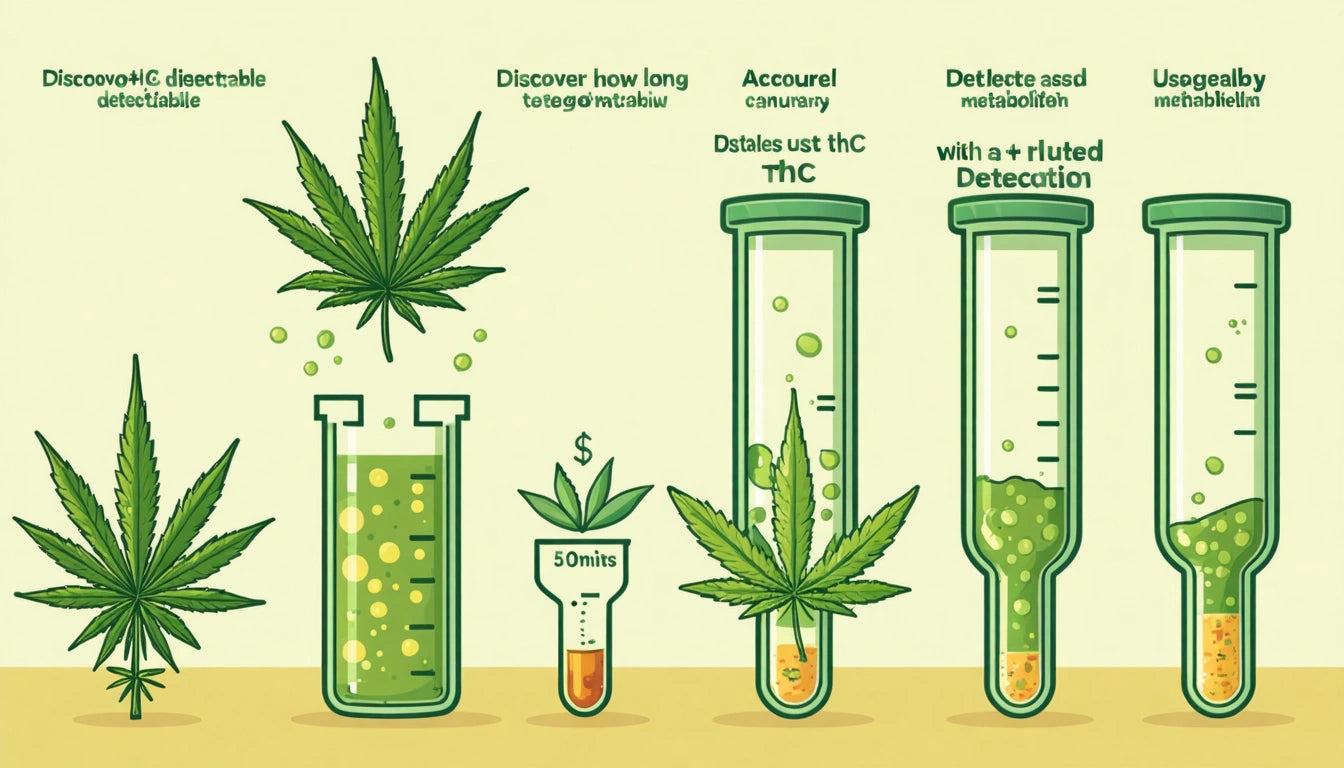Table of Contents
How Long Does THC Stay Detectable in Urine?
Understanding how long THC stays in your urine is crucial for anyone who may face drug testing or wants to understand how cannabis affects the body. THC, or tetrahydrocannabinol, is the primary psychoactive compound in cannabis that can be detected in bodily fluids for varying periods after use. Urine tests are the most common screening method due to their affordability and relatively long detection window.
THC Detection Windows in Urine: Timeline Breakdown
The detection window for THC in urine varies significantly based on usage frequency:
- Single use (first-time or occasional users): 3-5 days
- Moderate use (2-4 times per week): 5-10 days
- Heavy use (daily): 10-30 days
- Chronic heavy use (multiple times daily): 30+ days, potentially up to 90 days
These timeframes represent general guidelines, as individual detection periods for THC in urine tests can vary based on numerous personal factors.
Factors Affecting How Long THC Remains in Urine
Metabolism and Body Composition
THC is lipid-soluble, meaning it binds to fat molecules in the body. This characteristic significantly impacts how long THC stays in your system:
- Body fat percentage: Higher body fat typically means longer retention
- Metabolic rate: Faster metabolism may clear THC more quickly
- Age: Metabolism generally slows with age, potentially extending detection times
- Hydration levels: While not dramatically affecting elimination rates, proper hydration supports overall metabolic function
For a comprehensive breakdown of how these factors interact, you can review how THC behaves in blood, urine, and fat tissue.
Cannabis Potency and Consumption Method
Modern cannabis products vary widely in potency, which directly affects detection windows:
- Higher THC concentration products lead to longer detection periods
- Concentrates and edibles may result in longer detection times than flower
- Frequency of use has a cumulative effect on detection duration
When using cannabis products, many consumers rely on precise digital scales for accurate dosing to better manage their consumption and potentially minimize detection windows.
Urine Testing Methods and Detection Thresholds
Standard urine tests for THC typically screen for THC-COOH, a metabolite formed when the liver processes THC. Most tests use these common cutoff levels:
- Initial screening: 50 ng/mL
- Confirmatory testing: 15 ng/mL
Understanding these thresholds is important because they determine what constitutes a "positive" result. Some individuals may fall below detection thresholds earlier than the general timelines suggest, while others might test positive for longer periods.
How THC Metabolism Works in the Body
When cannabis is consumed, THC enters the bloodstream and is quickly distributed to tissues throughout the body. The liver metabolizes THC into several compounds, primarily THC-COOH, which is not psychoactive but is what most urine tests detect.
This metabolite is gradually released from fat cells back into the bloodstream and eventually excreted through urine. This process explains why THC can take significant time to leave your system, especially for regular users who accumulate more metabolites in their fat stores.
How Usage Patterns Impact Detection Periods
Occasional vs. Regular Use
The difference in detection windows between occasional and regular users is substantial:
- Occasional users may clear THC from urine within days
- Regular users experience a cumulative effect, with THC metabolites building up in fat tissues
- After cessation, heavy users may test positive for weeks or even months
This cumulative effect explains why detection periods vary so widely across different user profiles.
Tolerance Breaks and Detection
Taking a tolerance break not only resets your body's response to cannabis but also allows time for THC to clear from your system. However, for heavy users, even extended breaks of 2-4 weeks may not be sufficient to produce a negative urine test result.
For those concerned about detection, understanding how tolerance and detection windows relate can be valuable information.
Key Takeaways for Understanding THC Urine Detection
The question of how long THC remains in urine has no one-size-fits-all answer. Detection windows depend on a complex interplay of factors including usage patterns, individual metabolism, and the sensitivity of testing methods.
For those concerned about testing, remember these important points:
- Single use may be detectable for several days
- Regular use significantly extends detection windows
- Individual factors like metabolism and body composition play major roles
- No reliable method exists to rapidly clear THC from the system
Whether you're facing a potential drug test or simply curious about how cannabis interacts with your body, understanding these detection windows provides valuable context for making informed decisions about cannabis consumption.











Leave a comment
All comments are moderated before being published.
This site is protected by hCaptcha and the hCaptcha Privacy Policy and Terms of Service apply.